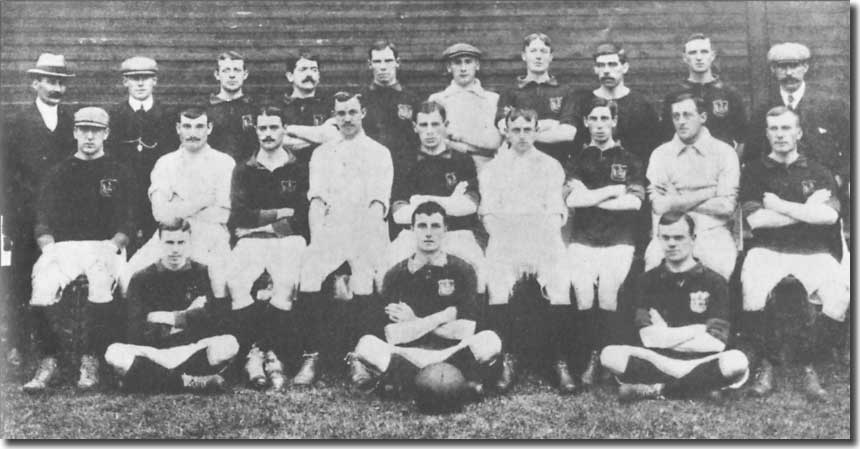 Part
2 - Results and table
Part
2 - Results and table
Leeds City AFC had made remarkable progress since the club's formation
in 1904, culminating in a promising debut among the Big Time Charlies
of the Football League. City ended 1905/06 in
a healthy sixth place in the Second Division and astounded many good
football judges with the quality of their play.
The club's directors were determined to build on these hopeful foundations
and took steps to ensure they had a home worthy of their ambition. The
board appointed a Ground Committee, comprising D Whitaker, R S Kirk and
R Younger, to oversee the development of the Elland Road stadium. They
had first hatched reconstruction and expansion plans when the club bought
the ground in 1905.
The board had been heartened by the patronage of football's powers-that-be,
eager to reward the emergence of a potential new stronghold of the game
in West Yorkshire. The Woollen County had always previously been a bastion
of cricket and rugby; only the more enlightened pioneers from the Sheffield
area had championed the upstart 'Socker', and the Football Association
were determined to reward converts to the dribbling code. They provided
official recognition by choosing Elland Road to stage a North v South
England trial match in January 1906. A month later, the City directors
launched the next stage of their development plans by paying out £420
to acquire 3,961 square yards of land on the Churwell and Geldard Road
side of the ground from the Monk's Bridge Iron Company.
Building work took much longer than originally planned. On 3 September
the Leeds Mercury explained the delay, reporting that the club
"had been handicapped in the construction of the grand stand owing to
the Corporation demanding that they should delve three feet below the
level of the rhubarb in the adjoining field!"
On 17 November, before the home match with Chelsea, the Lord Mayor, Joseph
Hepworth, father of the Leeds City chairman, Norris
Hepworth, formally opened the new grand stand. The Mercury:
'Saturday marked an epoch in the history of soccer in Leeds, and of the
Leeds City Club. The function was officially described as the opening
of the new grand stand, but it was something more than this. It was really
the opening of the new ground, and therefore an earnest beginning of what,
it is hoped, will be a long and prosperous career for Leeds City. The
club have now a magnificent ground, splendidly equipped in all departments.
'The new grand stand is a palatial structure, which has cost £3,000.
It gives seating accommodation for 4,000 persons. Some idea of its size
may be gathered when it is stated that it is 93 yards long and six yards
wide. Over half a mile of steel has been used in the formation of the
girders, and there are over 2,000 yards of corrugated sheeting in the
roof. Running underneath the stand its entire length is a training track
for the use of the players in wet weather. There are also dressing rooms
and officials' rooms, while at the Elland Road end of the stand a motor
garage has been provided, so that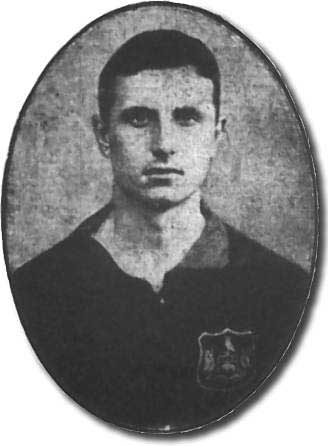 the management are quite up to date.'
the management are quite up to date.'
In addition, extensive drainage work was laid under the turf to deal
with the problems that had been experienced with waterlogged pitches all
through the previous season. The City players needed dry and firm conditions
to make the best of their passing game and had been forced many a time
to ply their trade in conditions resembling a swamp.
back to top
It was not just off the field, though, that things were developing, as
the club took steps to improve its playing strength during the summer
of 1906.
Grimsby Town tempted away both Jock Macdonald and Welsh international
Dickie Morris, while Bill Clay (Derry Celtic) and Harry Stringfellow (Preston
North End) also moved on. The club's ranks were swollen, however, by a
host of newcomers and there was a significant growth in numbers. Inside-left
Jack Lavery, goalkeeper Jack Whitley, and four Tottenham players, John
George (taking over from Dick Ray as
captain), James Freeborough, Willie Murray and George Page, all arrived
during the closing weeks of the season. The six were joined in the summer
by Plymouth Argyle left-back Andy Clark, wing-half Stan Cubberley from
non-league Cheshunt, Bradford City winger Bob Jefferson and Brighton half-back
Jimmy Kennedy.
In those days a Selection Committee determined the make up of the team.
Secretary-manager Gilbert Gillies
owed them a debt of gratitude for so enhancing his resources and he looked
forward with some enthusiasm to the new season, hoping that a decent debut
was merely the precursor to a promotion push.
The season kicked off on 1 September, and the opening day brought West
Yorkshire rivals Bradford City the short distance to Elland Road. Supporters
from both sides flocked to the contest, boosting the attendance to nearly
twenty thousand, although only 16,420 actually paid to see the game. The
receipts were £454, close to being a ground record.
Bradford had finished below the Peacocks in 1905/06, but were an accomplished
outfit, doing the double over Leeds. Their supporters looked forward to
seeing their own new recruits, Robert Campbell, Fred Farren, Leonard Newton
and James Garton, although their forces were depleted by the loss of fiery
forward Jimmy Conlin to Manchester City in the world's second £1,000 transfer.
The Bantams' followers could also marvel once more at the goalkeeping
phenomenon, William 'Fatty' Foulke, one of the most famous players of
his day.
Foulke joined Bradford from Chelsea five months previously, having won
FA Cup winners' medals with Sheffield United in 1899 and 1902, sandwiching
a final defeat in 1901. He won his only international cap in 1897, becoming,
at 6ft 6in, the tallest footballer ever to represent England, and he peaked
at a massive 26 stone during his spell with Bradford. In his time, goalkeepers
did not have to stay on the line when penalties were being taken and Foulke
used to race out to intimidate opponents with his massive physique, earning
a reputation as an expert penalty stopper. He once forced a game to be
stopped as a crossbar snapped under his weight when he made a save.
James Henderson, Charlie Morgan and Bob Jefferson were all unavailable
for Leeds, but Andy Clark and Jimmy Kennedy made their debuts as the Peacocks
lined up thus: Harry Bromage; David Murray, Clark; Jack Morris, John George,
Kennedy; Fred Parnell, Bob Watson, David Wilson, Jack Lavery, Harry Singleton.
Many of those players had been stalwarts the previous season, with Bromage,
Parnell and Wilson the pick of the bunch. It looked a decent side on paper,
but they quickly found themselves getting the runaround from opponents
who had enjoyed better pre-season preparation and looked considerably
the fitter of the two teams.
Flaneur in the Leeds Mercury: 'It was not a fit day for football,
with the thermometer 92 in the shade, and no player should have been asked
to play in such a temperature … As a test of endurance the encounter must
rank really high. The perspiration simply rolled down these well-trained
athletes, while the straw hatted, flannel-suited spectators almost groaned
in misery under the scorching sun.
'Those of us who had the fortune to secure some shade could well afford
to sympathise with the unhappy players. We assuredly admired them for
their pluck and stamina, and we admired the Bradford men more than their
rivals … They played with more dash and fire, and certainly with more
method. Their attacking movements were conceived with some skill, and
with an apparent understanding of each other's play, and as tacticians
they were far ahead of their opponents.'
Wallace Smith, a constant threat on the Bantams' right wing, opened the
scoring for Bradford in the first quarter of an hour after a beautiful
move. The goal only confirmed the visitors' dominance - they had a vice
like grip on the game and knew it, as did Leeds City.
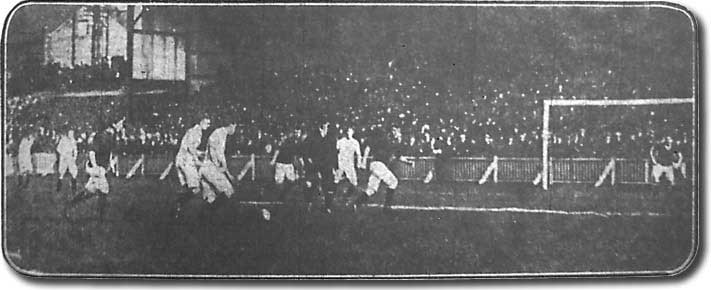 Harry
Bromage denied Bradford time and time again, stopping everything that
was thrown at him. The Bantams slackened off as time approached, convinced
they had done enough to secure the points, but their complacency was their
undoing. With five minutes to go, George, Morris and Wilson combined well
to contrive an opening for Lavery, who equalised with a low, slow shot
that goalkeeper Foulke never got near stopping.
Harry
Bromage denied Bradford time and time again, stopping everything that
was thrown at him. The Bantams slackened off as time approached, convinced
they had done enough to secure the points, but their complacency was their
undoing. With five minutes to go, George, Morris and Wilson combined well
to contrive an opening for Lavery, who equalised with a low, slow shot
that goalkeeper Foulke never got near stopping.
back to top
City had been badly outplayed but emerged with an undeserved share of
the spoils, as Flaneur observed: 'I heard two remarkable diverse opinions
on the result as the huge crowd emptied itself from the remodelled and
now excellently appointed Elland Road ground. One enthusiast asserted
that on the run of play the draw was a fitting result. But he was, no
doubt, a red hot Leeds partisan, and I imagine he had his tongue in his
cheek. The other pointed out that Bradford City ought to have won by six
goals. I am convinced he was a Bradfordian. The impartial man would strike
a balance between these two rather wild party opinions. He would tell
you, if he understood the game, that Bradford should have won on the play
by two or three goals, and he would be right.
'With the exception of Bromage, in goal, and Murray, at right-back, the
Leeds men were behind their opponents in all departments. Andrew Clark
seemed unable to cover the deficiencies of his half-backs as well as Murray,
who was always good. Both backs were, however, too hard worked.
'The half-back line was the worst department. Morris and George changed
places in the second half, but neither this couple nor Kennedy showed
such form as characterised the opposition. There was an entire lack of
combination between them and their forwards, of whom Wilson was the chief
disappointment. Parnell and Watson did fairly well, but Singleton lacked
dash and enterprise, and Lavery was no match for the tall Bradford captain
Robinson. It will not surprise me to find a few changes, especially in
the half-back line, in the Leeds City team for the next match.'
The performance was a bitter disappointment for everyone connected with
City, and the Selection Committee reacted anxiously with a number of changes
for the following Saturday's visit to West Bromwich Albion. Right-half
Morris was injured in the first half against Bradford, and was replaced
by George, whose position in the centre was taken in turn by Fred Walker.
Lavery and Singleton were summarily dropped, and Stan Cubberley and Willie
Murray were installed as the new left flank pairing.
The changes made no difference. Or, rather, they had an adverse impact,
and City returned from the Midlands on the wrong end of a 5-0 thrashing.
Nimrod in the Leeds Mercury: 'Leeds City have not improved. Their
exhibition against Bradford City was bad, but they gave an even more disappointing
display at the Hawthorns on Saturday when they met West Bromwich Albion.
'Although one did not expect the Elland Road men to return with points,
one hoped at any rate that the eleven would give a creditable account
of themselves. To be candid, however, they failed to do so in most lamentable
fashion, with the result that they were beaten by five goals to nothing.
Nor does the score at all exaggerate the superiority of the victors. Fore
and aft, individually and collectively, the Midland team were the masters,
and it was evident that there will have to be a vast improvement in the
general play of the Leeds City team ere points can be obtained.
'The great weakness in the half-back line was again emphasised. George,
Walker and Kennedy certainly tried hard, but they absolutely failed to
hold the nippy, clever and speedy forwards of the Albion team.'
City never got going, from the moment early on when Shinton opened the
scoring. Buck added a second around the quarter hour mark, and the two
scored again after the interval. Pheasant piled on the agony in the last
few minutes with a long-range skimmer to complete a miserable day for
Leeds City. It was very much a case of back to the drawing board for Gilbert
Gillies.
The same pattern persisted for several weeks, as the Selection Committee
chopped and changed the line up, to little benefit. By the end of November,
24 players had been tried with varying degrees of success, and only three
victories had been secured from 14 games. Leeds lay fifth from bottom
of the table, a mere two points above a re-election place.
| |
Bottom of Division Two - 24 November 1906 |
| |
Pos
|
|
P
|
W
|
D
|
L
|
F
|
A
|
Pts
|
| |
12th
|
Grimsby
Town |
14
|
5
|
1
|
8
|
18
|
23
|
11
|
| |
13th
|
Lincoln
City |
14
|
4
|
3
|
7
|
18
|
23
|
11
|
| |
14th
|
Burslem
Port Vale |
14
|
5
|
1
|
8
|
24
|
36
|
11
|
| |
15th
|
Chesterfield
|
14
|
4
|
2
|
8
|
16
|
24
|
10
|
| |
16th
|
Leeds City |
13
|
3
|
4
|
7
|
14
|
25
|
10
|
| |
17th
|
Barnsley |
13
|
4
|
1
|
8
|
21
|
20
|
9
|
| |
18th
|
Glossop
North End |
13
|
4
|
1
|
8
|
19
|
40
|
9
|
| |
19th
|
Blackpool |
14
|
2
|
4
|
8
|
12
|
25
|
8
|
| |
20th
|
Burton
United |
14
|
3
|
2
|
9
|
11
|
30
|
8
|
| |
|
|
|
|
|
|
|
|
|
This was a totally unexpected turn of affairs, and prompted a bout of
soul searching and derision from supposedly loyal supporters. The Leeds
Mercury carried a series of angry denunciations in the opening weeks of
the season, so pointed and barbed that they provoked retaliatory correspondence
from Gilbert Gillies.
'True Peacock': 'It is quite obvious that some changes must be made …
The passing of the forwards has been very weak, in fact, shocking to a
team like Leeds City. There has been an entire lack of fire and dash in
their play, and even when they get to the goalmouth they seem as if they
don't know where the net is.'
'Pitchfork': 'Now that we have seen the practice matches and the opening
match with Bradford City, and have been mercifully spared the blight at
West Bromwich, and carefully marked and digested the efforts of the club's
players, such as they are, it raises the above question in our minds.
'We take, for instance, Bradford City, who have as manager a tried and
approved player, who has this season put in the field a team that is a
credit to him and his club - a team that can practically do as it likes
with the Leeds team - and who have sold a player for £1,000. We dare not
allude to the eight goals' smashing the Reserves gave the Leeds Second
Team at Bradford. The majority of his players are smart young athletic
fellows gathered from various smaller clubs and so on.
'We take Hull City with its manager, Ambrose Langley, the old Sheffield
Wednesday player, a man who can spot young talent when he sees it, and
is capable of selling at a fancy price to the Leeds City Club David Wilson,
a man who has had his day, and Ambrose Langley knew it, if the Leeds City
management did not. Hull City Club's players are like Bradford City, for
the greater part, rising young players secured from smaller clubs, at
small prices.
back to top
'Candidly, leaving out these two capable and class men, Bromage and David
Murray, the composition of the Leeds City teams can best be described
as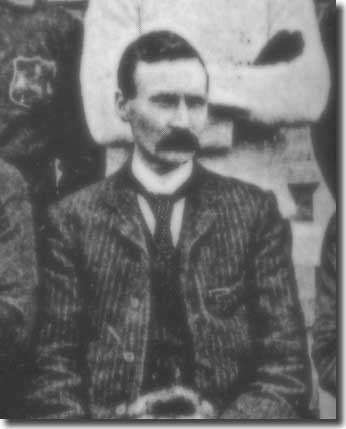 old crocks and League Club cast offs.
old crocks and League Club cast offs.
'Why not have secured as manager a man like Fred Spiksley, the old Sheffield
Wednesday internationalist. Leeds City had him here in Leeds two seasons
ago. What Fred Spiksley does not understand about football and young talent,
surely, should not be worth knowing.
'In conclusion, I am not picking out imaginary faults, and what is more
I have no axe to grind. What I like is to see a good football match, but
I am honestly convinced that under present conditions I shall be disappointed
at Elland Road.'
Gillies was stung into a sharp response and his letter was published
in the Mercury on 12 September: 'I am rather surprised that the
columns of your valuable paper should be open to letters such as the one
written under the nom de plume of 'Pitchfork'. When consideration is given
to the short period which Leeds City has been in existence, I think the
success it has attained is sufficient reply to the scurrilous attack.
'Comparisons are drawn between myself and other managers, but Pitchfork
seems to have forgotten that two of those named had teams and grounds
when they were engaged. The City ground was covered with Pitchforks -
weeds - when the club was formed into a company, and the team was not
even a skeleton of a West Yorkshire team, as reference to your files will
show.
'In reply to Pitchfork's attack on the players and myself … if he will
only have the courage to sign his own name and address, he will receive
a reply to that address which should remove his accumulation of bile and
spleen since he found himself on the wrong end of the fork.
'As far as the players and myself know - and we have the best of grounds
for saying so - we have only one enemy in Leeds. That enemy adopted several
nom de plumes last season, and spent his Sundays in writing letters to
the press when we had struck a bad patch, and Pitchfork's letter was in
the same old strain. Perhaps he is a disappointed man, as his letters
are all very much alike. Inquiries were made at one place last season,
but no one knew the name of the writer, who had given a certain address.
Having had some experience of Press work, and having on many occasions
read the postscripts, "Whatever you do, you must not publish my name,"
etc, I may say that I have the greatest contempt for the man, if such
he can be called, who attempts to injure others through the medium of
the press under a nom de plume.
'Considering the difficulties under which the season has been started,
I think the team ought to be at least given a chance until they are fully
represented, as it is early yet to pass, or to be a party to passing,
any such sweeping condemnations as used by Pitchfork. For True Peacock's
information I beg to state that at the time of the writing, Henderson,
Morgan, Walker, Morris, Wilson and Bromage are all on the injured list;
and to add to these misfortunes, Jefferson's services have not been available
up to the present.'
Gillies was not without his proponents and 'True supporter' offered an
ironic comment regarding the views of Pitchfork: 'On reading his (Pitchfork's)
letter, it makes one wonder how it was that the City officials missed
such a chance. His letter showed him to be a rare man with rare qualities.
Look at his reasonableness. Look at the unbounded confidence which he
has arrived at.
'I should like to suggest to the City officials that they make every
endeavour to get to know who he is and engage him. He would use such good
judgement that they would not need any committee meetings. He would always
do the right thing. He would never make a mistake, and before very long
we should have a team that would be able to hold its own with any First
Division club.'
The spat faded away after a while, but was evidence of the depth of local
feeling at the time, and the intense disappointment with the team's poor
form.
The three victories that were achieved during the first 14 games came
in successive matches during October as City climbed to 8th place, and
were quickly seized upon as evidence of a return to form. However, events
conspired to nip any chance of a revival in the bud, and bring a cloud
of despair to Elland Road, as tragedy struck the West Yorkshire club.
Centre-forward David Wilson collapsed in the second half of the home
defeat to Burnley on 27 October. He died of a heart attack in the dressing
room after returning to the field when John Lavery and Harry Singleton
sustained injuries. In a misguided sense of loyalty to the team, Wilson
threw away his life and left his team mates wracked with grief.
It was a tragedy of epic proportions and struck right at the heart of
the club's spirit and morale.
The aftermath of the game brought four straight defeats which saw the
club slump to the very edge of the re-election zone. Very soon, however,
a newcomer was to appear who would revive the fortunes of a club that
seemed dead on its feet and commence a celebrated association with Leeds
City. Billy McLeod was to become one of the most lethal finishers in the
game and establish a glittering reputation after he moved to Elland Road
from Lincoln City.
Other Football Highlights from 1906/07
- In winning the League title for the second time in three years, Newcastle
United dropped only one point at home. This came in their last home
match, but the point they earned from their goalless draw with Sheffield
United was enough to clinch the title. Newcastle lost at home in the
FA Cup first round to Crystal Palace, who were languishing near the
bottom of the Southern League at the time
- Newly promoted Bristol City came with a late run to earn runners up
spot in the League and Nottingham Forest won the Second Division title
- Sheffield Wednesday won their second FA Cup by beating holders Everton
2-1 in the final
- Celtic became the first club to achieve the Scottish League and Cup
Double and this was their third consecutive League title
- Wales broke the Home International stranglehold of England and Scotland
by winning the title for the first time. Manchester United's legendary
right winger Billy Meredith was their inspiration
back to top
Part
2 - Results and table
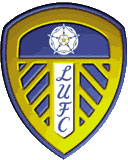











 the management are quite up to date.'
the management are quite up to date.' Harry
Bromage denied Bradford time and time again, stopping everything that
was thrown at him. The Bantams slackened off as time approached, convinced
they had done enough to secure the points, but their complacency was their
undoing. With five minutes to go, George, Morris and Wilson combined well
to contrive an opening for Lavery, who equalised with a low, slow shot
that goalkeeper Foulke never got near stopping.
Harry
Bromage denied Bradford time and time again, stopping everything that
was thrown at him. The Bantams slackened off as time approached, convinced
they had done enough to secure the points, but their complacency was their
undoing. With five minutes to go, George, Morris and Wilson combined well
to contrive an opening for Lavery, who equalised with a low, slow shot
that goalkeeper Foulke never got near stopping. old crocks and League Club cast offs.
old crocks and League Club cast offs.